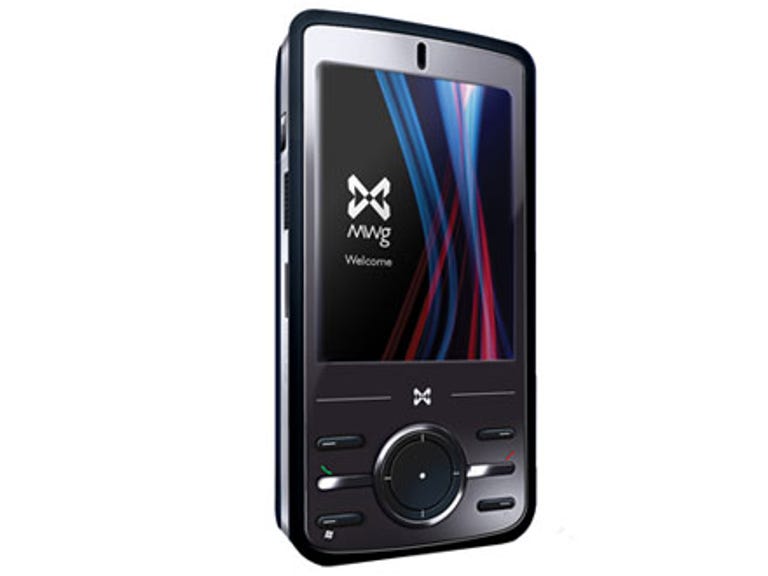 Why You Can Trust CNET
Why You Can Trust CNET MWg Atom V review: MWg Atom V
MWg's first Australian release is a solid Windows Mobile smartphone at a reasonable price, let down in part by sluggish performance.
Mobile and Wireless Group (MWg) is the remnants of the Asia branch of global telecom O2, and the Atom V is the next generation of handset in the O2 Atom line. This iteration has more features and a new design that's not quite like the older models. Does it have the potential to be as successful as the previous devices like the Atom Life?
The Good
The Bad
The Bottom Line
Design
Design is an important reason the Atom Life was successful, and the Atom V looks to emulate that. Though not razor-thin like so many consumer mobile phones these days, the Atom V is pretty slim, measuring in at just under 15mm, down from the Atom Life's 18mm. There is a bit of sacrifice in the length and width, though. The Atom V has a noticeably larger footprint and does not look as compact as the older Atoms.
Like HTC's Touch series, the entire front surface of the device is flush. This means there is no raised bezel, which makes it better for fingertip actions like scrolling and swiping. We did find the LCD quite far under the clear plastic cover, which makes it difficult to aim at small icons, especially if the screen is placed at an angle from your view. On a related note, the stylus that comes with the Atom V is too short for comfort — MWg should have provided an extendable one.
Below the display is a round directional pad. At first glance, you expect it to be a scroll wheel because of the shape, but unfortunately, it's not. The lack of circular motion doesn't take away from the fact that it's a pretty effective five-way navigator. We especially like that the selector is very large so you can't possibly miss it. Around this navigator are the shortcut buttons. These are thinly shaped but well spaced out so we had no problems with them.
On the left side of the Atom V is the camera shutter, a volume rocker which doubles as another shortcut key and the microSD card slot. Connections-wise, there's a standard mini-USB port on the base and a 2.5mm audio jack for headsets on the right side.
Features
The size of the Atom V doesn't limit what it's able to do and it remains as fully featured as the Atom Life. This includes HSDPA, Wi-Fi and Bluetooth wireless connection options as well as quad-band GSM, a feature that frequent travellers to the US will appreciate. For those who still like to listen to the radio, a tuner is also built into this handheld.
Another feature that globetrotters will like is the inclusion of GPS. This was one feature that gave the HTC P3600i the upper hand when comparing features. The GPS in the Atom V will utilise the tried-and-tested SiRFStar III chipset. It worked well with Google Maps, taking only about a minute to get a lock.
One of the most glaring omissions is the lack of a secondary camera for video calls. Though it is equipped with 3G, there is only one rear-facing camera for still snapshots and video capture.
Though still fast at 520MHz, the Atom V's processor is slower than the Atom Life's 624MHz one. It may not mean a lot to most users, but those switching over from an Atom Life may feel the difference.
Though many handhelds now come with 128MB RAM, the Atom V sticks with 64MB. RAM is temporary memory for running applications, so more of it will make multitasking more efficient. Considering the Atom V runs Windows Mobile 6.0, an operating platform that requires a fair bit of grunt, an increase in memory is something we really regret not seeing in the Atom V.
One of the things we liked about O2 products was the effort taken to customise the software. On the Today screen, this is usually done by adding new rows and shortcuts to make getting to commonly used items more convenient. MWg has taken another step by providing an attractive alternative to the default Today screen in an app named Atom V Quick Menu. This interface features large icons on the bottom of the screen which are meant to be tapped with your fingers. Icons can be removed or added from a comprehensive list and moving between them is intuitively done by swiping your thumb against the row. A big clock is found in the middle of the display, while the top of the screen shows system information and fixed shortcuts to messaging, the phone application and keylock. This is definitely much easier to use than the regular Today screen. But if asked to make a choice, we'd have to say that HTC's implementation is still more comprehensive and useful.
Another useful feature is the Easy-Touch Menu. This can be called up by pressing and holding the Windows key. What it does is to help you easily terminate the application you are in because, as we know, pressing X on the top right corner only minimises them. This will help with RAM management. It also has a shortcut to the brightness setting, making it convenient to adjust the backlight to save power.
Performance
On a single charge of the battery, we got about two days' use. As mentioned earlier, we found RAM lacking on the Atom V. With nothing running in the background, there was only about 22MB of free RAM on our review set. With the Atom V Quick Menu running (which we think most users will leave on by default), there was only 18MB free. The responsiveness of the device felt fine in most normal operation but we did experience some slowdown when more applications were running in the background.
